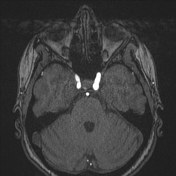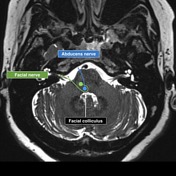15,145 results found
Article
14-3-3 protein
14-3-3 proteins are found in the cerebrospinal fluid (CSF) and are currently used to help identify patients with sporadic Creutzfeldt-Jakob disease (sCJD).
Seven distinct 14-3-3 proteins have been found in humans.
In diagnosing sCJD, the sensitivity of 14-3-3 protein is 92%, and its specifici...
Article
18q deletion syndrome
18q deletion syndrome is a rare chromosomal anomaly where there is a deletion of part of the long arm of chromosome 18. Associated symptoms and findings vary widely, as do their severity. Characteristic clinical features include short stature, intellectual disability, hypotonia, facial, and dist...
Case
18q syndrome

Published
24 Jan 2010
62% complete
MRI
Article
1p19q codeletion
1p19q codeletion stands for the combined loss of the short arm chromosome 1 (i.e. 1p) and the long arm of chromosome 19 (i.e. 19q) and is recognized as a genetic marker predictive of therapeutic response to both chemotherapy and combined chemoradiotherapy and overall longer survival in patients ...
Article
2-hydroxyglutarate
2-hydroxyglutarate (2HG) is a metabolite that accumulates in the brains of patients with IDH1 mutated (IDH1 positive) brain tumors, particularly diffuse low-grade gliomas. Although not in widespread clinical use, it is likely that 2-hydroxyglutarate, which resonates at 2.25 ppm, will be able to ...
Article
5-ALA fluorescence-guided surgery
5-ALA fluorescence-guided surgery is an intraoperative technique that takes advantage of tumor cells accumulating a fluorescent compound to make the location of the tumor more readily apparent. It is primarily used in the resection of high-grade gliomas (e.g. glioblastoma, grade 3 or 4 astrocyto...
Case
A1 segment hypoplasia

Published
27 Oct 2020
77% complete
MRI
Case
A1 segment hypoplasia

Published
23 Nov 2021
83% complete
MRI
Case
A1 segment hypoplasia

Published
26 Oct 2016
83% complete
MRI
Article
ABC/2
ABC/2, also confusingly written as 1/2ABC in some literature, is a fast and simple method for estimating the volume of intracerebral hemorrhage (or any other ellipsoid lesion for that matter) which does not require volumetric 3D analysis or software.
Intracerebral hemorrhage volume is an import...
Case
ABC/2

Published
22 Sep 2022
29% complete
Diagram
Case
Abdominal CSF pseudocyst

Published
20 Oct 2010
13% complete
Case
Abdominal wall pseudocyst complicating a lumboperitoneal shunt

Published
20 Jan 2019
83% complete
CT
Case
Abdominal wall pseudocyst secondary to lumboperitoneal shunt malpositioning

Published
07 Feb 2022
95% complete
CT
Case
Abducens and facial cranial nerves and nuclei

Published
23 Jan 2017
32% complete
Diagram
Article
Abducens nerve
The abducens nerve is the sixth cranial nerve (CN VI). It is a motor nerve responsible for abduction of the eye (TA: nervus abducens or nervus cranialis VI). It courses from the abducens nucleus, located in the dorsal pons, up to the cavernous sinus, via a long cisternal segment that is prone to...
Case
Abducens nerve on MRI

Published
09 Apr 2012
95% complete
MRI
Case
Abducens nerve palsy

Published
08 Feb 2017
71% complete
MRI
Case
Abducens nerve palsy

Published
07 Dec 2017
65% complete
MRI
Annotated image
Article
Abducens nerve palsy
Abducens nerve palsy, or sixth nerve palsy, results in weakness of the ipsilateral lateral rectus muscle.
Clinical presentation
Patients present with horizontal diplopia with an inability to abduct the ipsilateral eye, thereby resulting in an esotropia (nasal deviation of the eye).
Pathology
...









 Unable to process the form. Check for errors and try again.
Unable to process the form. Check for errors and try again.